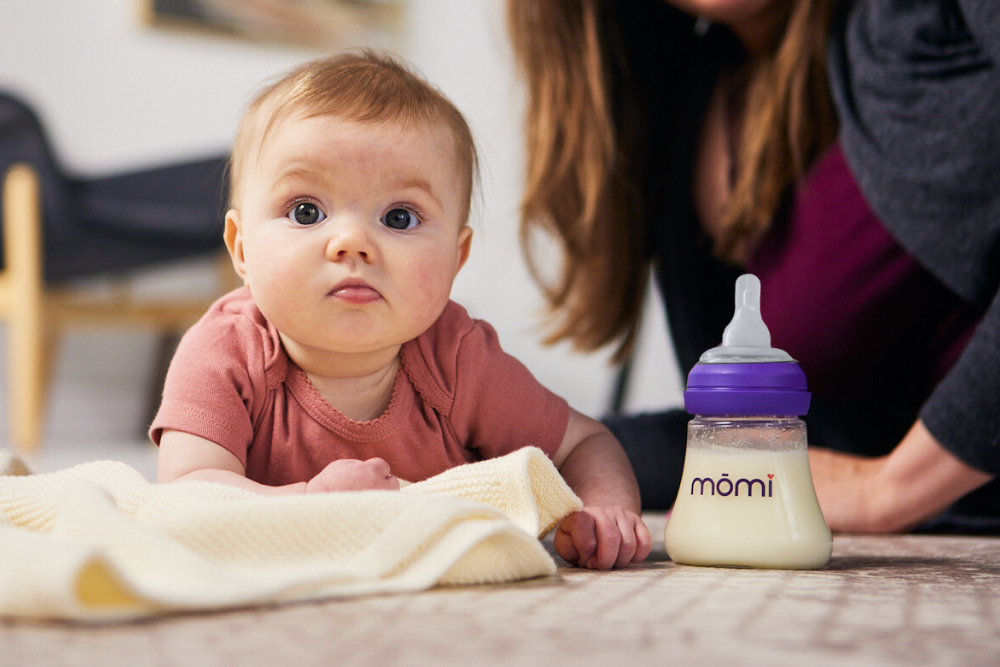Infant feeding shouldn’t feel like rocket science, right?
But the truth is, it is quite complex! And when bottle feedings are unregulated, or unpaced, they can cause problems like gas, regurgitation, and breast refusal.
And that is the last thing a sleep-deprived, new mom needs!
The technique of paced bottle feeding helps address these problems, but requires some practice. Even then, practicing paced bottle feeding can stretch feedings out to 20 or 30 minutes.
The mōmi bottle has pacing built-in paced feeding, allowing the baby to regulate the flow so you don't have to. With mōmi, infant feeding can be simple and easy, so that even Grandpa can do it!
Understanding Bottle Feeding
Babies nurse and bottle feed – and a vast majority do both:
And while feeding sounds deceptively simple (and how we wish it were!), switching from breast to bottle to breast again, regardless of the type of milk in the bottle, can be anxiety provoking and challenging for mom and baby!
Of course, this journey depends a lot on the baby’s ability to tolerate the different feeding forms and their preference for one over the other.
Some babies may struggle with the mechanics of the different feeding modalities, (nursing vs. bottle feeding), and some may develop a preference for one over the other (hello, nipple confusion or refusal).
And others may suffer the side effects of unregulated feedings. (Projectile spit-ups!)
This is where it gets complicated and is the reason why we created a bottle that is engineered like a breast, thereby making paced bottle feeding easy, convenient, and foolproof.
Let’s look at why it is important to adopt the paced feeding technique with babies:
1. Conventional Bottles Can Cause Overfeeding In Infants
Unregulated or unpaced feeding with a regular or conventional bottle can cause overfeeding, which then leads to problems like obesity, gas, and discomfort, and could mean sleepless nights for you.
And while baby bottles may not look particularly complicated to adults, for an infant, they are a complete departure mechanically from nature’s design of nursing.
A traditional bottle-feeding technique takes away an infant’s ability to self-regulate their feeding.
This is because conventional bottle nipples function differently than natural nursing due to their hollow design, stiff material, and drip flow through the nipple orifice.
These fundamental properties of conventional bottle nipples require that babies adapt to the rigid material in the mouth, adapt to the flow speed of the nipple through the nipple orifice, and adapt their tongue motion to stop the milk flow using the tongue as a stopper.
However, in natural nursing, the method is completely different.
Babies use their oral mechanics to stretch and compress the naturally pliant maternal tissue while regulating the speed and volume through their own natural sucking/pausing patterns.
This allows the baby to self-regulate the speed and volume of the feeding, thus avoiding overfeeding.
2. Nursing Allows Babies to self-regulate feeding
During a nursing session, the baby is literally in control of the feeding. (I’ve got this, Mom!)
However, when we use a conventional bottle, we take away this control, and the baby instead becomes a passive participant. Without control of the speed through oral mechanics, the milk can flow too quickly through the nipple orifice, which often results in choking and flooding of the mouth.
3. Unpaced Bottle Feeding Can Lead To Regurgitation And Spit-Up
Another reason experts recommend paced feeding techniques is because unpaced bottle feeding can lead the baby to unwillingly drink large volumes of milk. This can cause discomfort and lead to regurgitation or spitting-up of the excess milk.
Recurrent regurgitation leads to an increased risk of causing gastroesophageal reflux disease (GERD) or heartburn from stomach acid. That in turn can negatively affect the infant’s esophagus tissue while also wasting precious breast milk.
4. Conventional Bottles can lead to Breast Refusal
Last but certainly not least, one of the most important reasons to consider paced feeding techniques is breast refusal.
Even though infants can find learning a new set of oral mechanics for feeding a bit challenging, when offered both options, the bottle and the breast—babies tend to gravitate towards the faster, easier conventional bottle feeding experience.
In fact, some infants prefer the ease of conventional bottle feedings so much that they refuse to return to the breast. Breast refusal, also known as “breast rejection,” is quite common in babies who are introduced to the bottle in the early months.
Since conventional feeding seems easier than active nursing, they begin to prefer it over working to achieve maternal milk letdown.
What is the Paced Bottle Feeding Method?
The cons of conventional, unregulated bottle feeding have led to the development of paced feeding practices. But what exactly is it and how can you start?
Well, paced bottle feeding is a method that aims to return feeding self-regulation to the infant by mimicking the breast-feeding experience for the baby.
The goal here is to slow the feeding pace and return control of the feeding to the baby. This technique reduces the risk of overfeeding and is recommended for all bottle-fed infants, not just those who are dual feeding from breast and bottle.
What Does Paced Bottle Feeding Look Like?
Sounds easy enough, but is it?
So, it can take a bit of practice.
During a paced bottle feeding, caregivers intentionally have to take breaks during the feeding and alter the feeding technique to engage the baby. They do this as they carefully watch the infant for signs of fullness or satiety. They also have to alter the traditional feeding positioning to slow the milk flow through the nipple.
Another important practice is to hold the infant in a more upright position, keep the bottle horizontal, and mindfully slow the feeding speed. This also requires them to take regular breaks from the feeding—as often as every 3–5 sips and wait for ongoing hunger cues to restart the feeding.
In order to focus on preserving nursing, some paced bottle-feeding experts recommend shifting the infant’s position to the other arm to mimic the shift from breast to breast.
The objective of this technique is to slow down the process and allow the infant to learn fullness cues, which in turn helps them retain their ability to demonstrate satiety and stop feeding when full.
Not as Easy as It Looks: The Cons of Paced Feeding
With a bit of practice, many caregivers, particularly dedicated parents, get the hang of paced bottle feeding.
However, it turns feeding sessions into prolonged episodes, lasting up to 20-30 minutes per feeding.
With the first three months already being difficult and overwhelming for new parents, paced feeding can become quite exhausting!
After all, it is a technique that requires patience and attention. On top of that, it also requires that all caregivers feed the baby using this technique. This can get tricky for parents who drop off infants at daycare or have caretakers for whom instruction and learning can be stressful and difficult to grasp.
mōmi lets the baby set the pace
But what if we could design a bottle with paced feeding automatically built in?
That’s what our team of engineers worked on when they designed the mōmi bottle. It wasn’t just designed to look like a breast; it was engineered to function like one.
With paced feeding automatically built in, the bottle and nipple system removes all the challenges of paced feeding while providing all the benefits!
With its patented babypace® technology, the mōmi bottle returns the self-regulation of feedings to the infant without adding stress to the caregiver. Now whoever is on feeding duty does not have to alter the bottle-feeding technique because the bottle/nipple system already mimics nature.
The mōmi bottle’s patented design replicates the natural biomechanical properties of natural nursing and allows infants to use their natural oral mechanics to regulate the speed and volume of feedings by responding to compression shutoff.
We also took a few extra steps and made it even better by designing the mōmi nipple to be as soft and stretchy as a gummy bear. Its central duct can compress to 80% of its original diameter with less than 1 pound of force.
Why?
So, that your baby can easily stop the flow of milk in the same manner as nursing at the breast.
The active work of engaging in compression shutoff slows the feeding speed, tires the baby, and helps to avoid the overfeeding associated with passive traditional bottle feeding.
Alas, no flooding of the mouth, no risk of choking or glugging down ounces and ounces of milk.
Now you can even read a few emails as you feed your infant, watch a sunset, or just relax and admire their delicate features without stressing over sips, position, and feeding cues.
The mōmi bottle doesn’t just make paced bottle feeding a breeze, it also lets you focus on bonding and enjoying the feeding experience with your little one, just like the breast.




